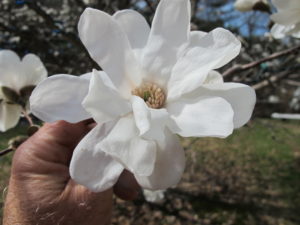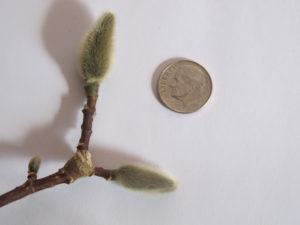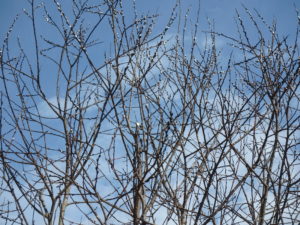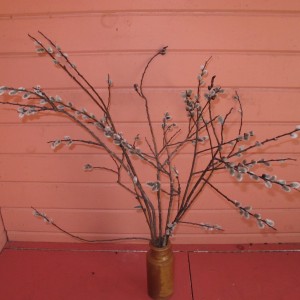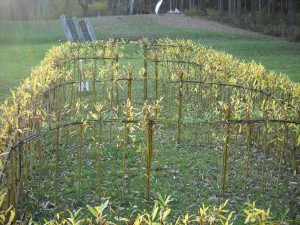Forcing Flowers of Shrubs and Trees
When I was in first grade we learned a song about pussy willows that still rings in my head when I walk past the fire pond in Cornish Flat. Or it did recently when I saw pussy willows starting to pop open in a marshy area. Spring is here.
Pussy willows are actually the flowers of a wild shrub or small tree, the goat or pussy willow, also known by its scientific name, Salix caprea. This willow is a native to the United States and grows best in moist or soggy soils, or even in standing water. Full sun is best, but it can grow in part sun. It will grow up to 25 feet tall, but 15 feet is more common. The flowers grow on the top of the plant, so I use a pole pruner to get the branches I want.
Another willow, Salix discolor, is also a pussy willows but is “susceptible to a canker and is considered inferior for landscape use, though neither species is a plant of the first order.” That according to Michael Dirr in his book Manual of Woody Landscape Plants which I consider my bible of trees and shrubs.
He is right about pussy willows not being plants of the first order. Their time of glory is the spring, when the catkins or blossoms appear. The rest of the year it is a relatively unkempt, messy plant that spreads and is often too large to be considered a shrub, but not big enough to be considered a tree. The stems are weak, sometimes flopping over and easily breaking in ice storms. Still, if you have a wet area on your property, and like fat, fuzzy pussy willows in the spring, you should have some.
When I picked some pussy willow stems recently, I put them in a vase with water. This will encourage un-opened buds to open. Later, when all the blossoms are fully open, I will pour out the water and allow the stems to remain in a dry vase. This will prevent them from producing yellow pollen (which will fall on the table top) and allow me to have the fuzzies forever, or at as long as I want. One year, inadvertently, I kept a vase of pussy willows for a full year, and they still looked good!
Another plant that can be forced to flower now looks similar to pussy willows at a quick look. I have a tree covered with fuzzy buds that are actually unopened flower buds that look like the pussy willow flowers. The hybrid magnolia ‘Merrill’ has these buds all winter, but when put in water now the buds will produce large white blossoms. Other magnolias have similar buds – like pussy willows on steroids.
The Merrill magnolia will generally bloom for me in late April. The closer to the date of outdoor blooming, the quicker buds will open in a vase indoors. I once did some pruning in December and forced magnolia buds indoors, but it took over a month for that to happen. Now it should happen in half that time (though pussy willow buds will open in just a few days).
My Merrill magnolia is one of my favorite trees. Mine is about 20 or 25 years old, and is roughly 30 feet tall with a 20 foot spread. When it blooms the flowers are bountiful – a thousand, perhaps – and magnificent. Each blossom is about 3 inches across and lightly fragrant. I recommend them as specimen trees in the middle of a lawn or field in full sun.
Another classic early spring shrub is forsythia. Like the daffodil, this early bloomer is bright yellow, a color I have come to associate with spring. It can be used as a hedge, or pruned into a vase-shaped shrub that stays relatively small, say 8 feet tall and 6 feet wide.
To get forsythia to bloom, pick stems that are more than one year old. New stems are generally straight, with few side branches and even fewer buds. The buds on new branches tend to be leaf buds. Older branches will be branched, and loaded with flower buds. And for best results, don’t forget to change the water in the vase every 2 or 3 days.
Forsythia is a nice enough plant, but like pussy willows, it is not my favorite. It is rambunctious, for starters. It wants to take over the world, sending out roots that then send up new plants. My neighbor planted a forsythia hedge, and now I have forsythia that has encroached onto my land. Fortunately, it is easy enough to control if you pull out new shoots early on. Or failing that, cut them back every year.
As a child, however, I loved forsythia. My gardening grandfather planted a double row of them between the house and the vegetable garden. As the plants grew and spread they became a dense thicket perhaps 40 feet long, 10 feet wide and 10 feet tall. My sister Ruth Anne and I discovered that if we crawled into this thicket there was a hidden ”room” in the middle where we could hide from adults on hot summer days.
Apple blossoms are great for forcing, too. When I prune in March I take branches with short fruit spurs, put them in a vase, and get flowers. At this time of year, one can’t have too many blossoms!
Read Henry’s twice-weekly blog at https://dailyuv.com/
Pussy Willows
In general, I don’t sing. I can’t carry a tune, and words to even the simplest of songs seem to disappear from my brain in about 20 minutes. Always have. So it was a surprise to me when, walking by a clump of pussy willows, I remembered a simple childhood tune about them and was inspired to sing it – and to ponder the joys of pussy willows. They are cheerful flowers that appear just when we need something lovely in the garden. To me they are pure fun, and not just for little children. We should all have some.
What we call pussy willows are actually the male catkins – pollen-producing parts – of two species of willows (Salix caprea and Salix discolor). Both grow wild, and are available at nurseries. Pussy willows, like all willows, like wet, swampy areas. They will grow up to be small trees, but can be kept to a manageable size with yearly pruning – and now is a good time to do so.
Fortunately for those of us who depend on pussy willow bouquets to chase away the mud season blues, the more you trim your pussy willows, the more vigorous and productive they will be. Left un-pruned, pussy willows can easily reach 20 feet tall. Since they bloom on their upper branches, picking good-looking stems can be next to impossible if the bushes are allowed to get too tall.
When harvesting pussy willows in the wild I bring along a pole pruner. Any type will work, but I like mine best: it’s an ARS brand, model 180L 1.8. Unlike other pole pruners I’ve tried, this has a handle to squeeze, just like regular pruners (not a string or handle to pull). That feature allows me to have great control. With it I can reach up and nip off pussy willows that are 12 feet or more above ground.
The pole pruner in question is made by a Japanese company, ARS, and is available from OESCO, a tool dealer in Massachusetts (www.oescoinc or 800-634-5557). Not only that, it weighs less than 2 pounds, so it is easy to maneuver with one hand. It is not designed for use on anything thicker than about three quarters of an inch in diameter. Cost? About $95 plus shipping and worth every penny. I also use it to cut the dead stems in my blackberry patch. I can reach in with it to cut ta cane, then grab it and pull it out.
In addition to bringing spring into the house, pussy willows are great for honeybees. According to beekeeper Margot Maddock of Lyme, NH, pollen from pussywillows is one of the first sources of food for honeybees in the spring. It is even earlier than that nuisance in the garden, chickweed, which is also good for the bees.
If you put your cut stems of pussywillows in a vase and add water, they will continue to mature and produce a yellow pollen that will eventually fall on your tablecloth. But if you put them in a dry vase, they will stay frozen in time. I’ve been known to keep pussy willows looking good on my desk for months that way.
Rooting pussywillows is easy. Cut a stem about a foot long and push most of it into the soil where you would like to have pussy willow growing. But be sure that you keep track of which end is up, and leave a couple of inches sticking out of the ground. If leaves or side shoots have started to grow by the time you do this, rub them off before you push the stem into the ground. Although pussywillows grow best in moist soil, they will grow in ordinary garden soil, too. You will just need to be sure the soil does not dry out until the stem is well rooted.
Because pussy willow is so easy to root, you can easily make a living wall or windbreak. I worked on a willow farm in France a few years ago. The farmers grew willow for basket making, but also created living sculpture. Young willows – two to 3 years old – are so flexible you can braid or weave them if they are planted close enough together. You can also tie stems together to create a tunnel for kids to play in.
Charlet Davenport of Woodstock, Vermont, commissioned a work of art using living willow for her Sculpturefest that is held each year in August (www.sculpturefest.org). Early spring is best time to root willows, but the artist who made the sculpture for Sculpturefest keeps willow stems in big coolers so that she always has dormant willows to root for art projects.
You don’t have to depend on nurseries and greenhouses for all your plants. If you want to pick some willow stems and plant them, they will probably grow – for free. You just need a little patience for them to reach full size.
Henry Homeyer can be reached by e-mail at henry.homeyer@comcast.net or by mail at P.O. Box 364, Cornish Flat, NH 03746. He is a UNH master Gardener and the author of 4 gardening books. His Web site is www.Gardening-Guy.com.



